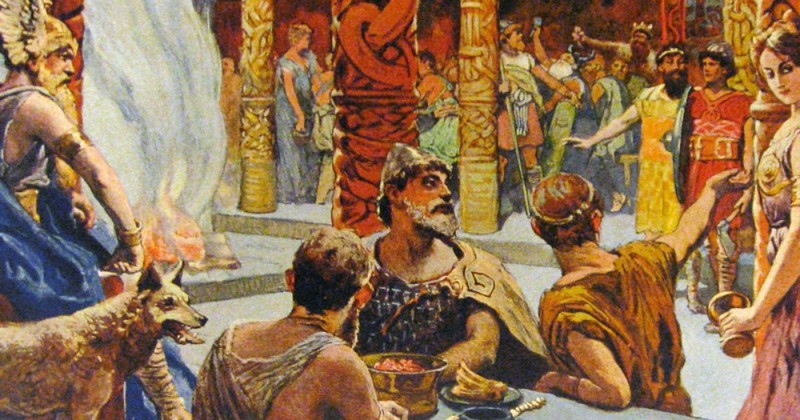The 6 most famous Viking gods

Thor is the best known, but behind him are a number of fascinating mythological beings.
It has been about three years since the first pagan temple was inaugurated in Iceland, by the neo-pagan association Asatruarfelagid, where veneration and worship of the Viking gods takes place. Without apparent scientific explanation, the rise of this type of religions or sects is spreading throughout northern Europe, especially in the Scandinavian regions.
Returning to the data of the mentioned associations, only the Icelandic one has tripled the number of members in 10 years of history. In order to avoid the controversy generated by this phenomenon, the highest authority of the Asatru association, Hilmar Örn, vindicates the metaphorical and poetic role of their beliefs. Shying away from the bad image generated, the priest claims not to believe in monstrous beings with mutant heads and green skin.
However, the Viking gods were once the Viking gods were entities in which this Nordic people fervently believed.. Even today, the mythology associated with them continues to arouse the fascination of many people.
The main Viking gods
Norse and Germanic mythology is full of super-powerful beings that have to do, mainly, with the earth and nature. Below you will find a brief explanation of the most important Viking gods.
1. Thor
Today, he appears in movies, comics, comic books and even on cereal. In the present, the god Thor is surely the most popular Viking mythological being worldwide.. Son of Odin, the god of gods, Thor represents strength, power and war. A blond or red beard and a fierce look were part of the physical characteristics with which he was usually described, although almost as important as himself was his weapon.
Thor is always depicted wielding a hammer known as mjolnir, forged by dwarves. His means of transportation was an imposing chariot pulled by goats whose pace was marked by sounds emulating thunder and lightning.
2. Odin
As we have mentioned in the first place, Odin was the god of the gods, to whom it was necessary to pay obeisance. Father of Thor, he possessed some of the characteristics that he transmitted to his son: strength, dexterity, war, intelligence and cunning. It was his raison d'être, knowledge and wisdom. He changed his being to acquire more intellect, and was always accompanied by crows. was always accompanied by ravens.
In order to increase intelligence, Odin was associated with human and animal sacrifices, which caused him to lose an eye. It is said that the English word "Wednesday", day of the supreme god, is due to the English name: "Woden".
3. Frigg
She is the wife of Odin and stepmother of Thor. This Viking deity represented love, fertility, marriage, motherhood and the art of home. and the art of the home. As a special power she had the quality of prophesying, knowing and knowing the fate of all humans, as well as the only one, after Odin, to occupy the throne of the gods and observe the universe.
It is said that the origin of the word "Friday" in English, which means Friday, comes from the Germanic origin "Freitag", whose epistemology has much to do with this Viking goddess.
4. Tyr
Within the Germanic-Nordic mythology, the god Tyr is considered the absolute warrior among all the Viking gods. Although most of his encounters, stories and narratives have to do with war and force scenarios, he was not an exclusively brute character, but he is also attributed with iconographies associated with wisdom and laws.
In the same way, he also made a self-sacrifice and had his left arm amputated. amputated his left arm so that the gods would save the world from Fenrir the wolf.. It should be noted that only Thor surpassed him in terms of physical strength.
5. Freyja
She was the goddess of love and fertility, beauty and romance. She was madly in love with her husband Odr. It is said that when he went away from her, Freyja would burst into tears and, as beautiful as she was, would shed golden tears between her eyelashes. For these reasons, among others, she was one of the most respected deities, although from the modern perspective it seems rather a grouping of characteristics traditionally associated with the feminine..
Her clothing was worthy of what she represented. Beautiful, glittering and precious necklaces, a hypnotic plumage that allowed her to fly between the underworlds and a chariot carried by marvelous felines were part of the objects with which she was represented. Although she was the least warlike deity, she accompanied soldiers and gods to war to instill security and motivation, as she was considered a sage.
@image(id)
6. Loki
According to Norse mythology, Loki is the son of the giants Laufey and Farbauti, and is characterized by his ability to deceive and wreak havoc.. In fact, he is technically not a god, but a mysterious entity that mingles with the gods or even impersonates one.
There is very little information about Loki and it is not well known to what extent he was part of the original pantheon of Norse mythology; however, his influence has been reflected in Western culture through all kinds of stories and even operas, films, novels, etc.
(Updated at Apr 13 / 2024)